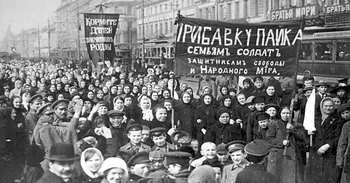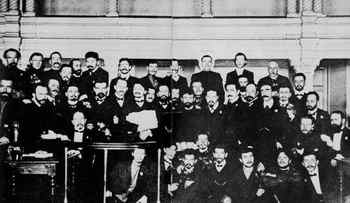Part 1 of the Series: Centenary of the Russian Revolution and the Repudiation of Debt
Russia: Repudiation of debt at the heart of the revolutions of 1905 and 1917
by Eric Toussaint
February 23, 1917: Womens protest in Petrograd
 In February 1918, the repudiation of the debt by the Soviet government shocked international finance and sparked off unanimous condemnation by the governments of the great powers.
In February 1918, the repudiation of the debt by the Soviet government shocked international finance and sparked off unanimous condemnation by the governments of the great powers.
This decision of repudiation was intrinsic to this first big movement for social emancipation which rattled the Russian Empire in 1905. This huge revolutionary uprising was caused by the conjunction of many factors: the Russian debacle in its war with Japan, the wrath of peasants demanding land, the rejection of autocracy, workers’ demands... The movement began with strikes in Moscow in 1905 and soon spread throughout the empire like wildfire, adopting different forms of struggle. Out of the process of self-organization by the masses emerged councils, or soviets in Russian: peasants’ councils, workers’ councils, soldiers’ councils and so on.
Trotsky, who presided over the soviet of St Petersburg (capital of Russia until March 1918), explained in his autobiography that the arrest of its entire leadership on December 3, 1905 was triggered by the publication of a manifesto in which the elected members of the council appealed for the repudiation of debts contracted by the Tsarist regime. He also explained that this 1905 call for the non-payment of the debt was finally realized in early 1918 when the Soviet government adopted a decree for the repudiation of the tsarist debts:
“The arrest took place a day after we had published our so-called financial manifesto, which proclaimed that the financial bankruptcy of Czarism was inevitable, and issued a categorical warning that the debts incurred by the Romanovs would not be recognized by the victorious nation. |1| |2|
Trotsky (holding the brief case) among the members of the Petrograd Soviet, during their trial
 “The manifesto of the Soviet of Workers’ Delegates plainly declared:
“The manifesto of the Soviet of Workers’ Delegates plainly declared:
‘The autocracy never enjoyed the confidence of the people, and was never granted any authority by the people. We have therefore decided not to allow the repayment of such loans as have been made by the Czarist government when openly engaged in a war with the entire people.’
“The French Bourse answered our manifesto a few months later with a new loan of three-quarters of a million francs. The liberal and reactionary press poured sarcasm over the important threat of the Soviets against the Czar’s finances and the European bankers. In later years, the manifesto was successfully forgotten but it recalled itself to mind. The financial bankruptcy of Czarism, prepared for by its whole past history, coincided with the military debacle. And later, after the victory of the revolution, the decree of the Soviet of People’s Commissars, issued on February 10, 1918, declared all the Czarist debts annulled. This decree remains in force even to this day. |3| It is wrong to say, as some do, that the October Revolution does not recognize any obligations: its own obligations the Revolution recognizes to the full. The obligation that it took upon itself on December 2, 1905, it carried out on February 10, 1917. The Revolution is fully entitled to remind the creditors of Czarism: ‘Gentlemen, you were warned in ample time.’
“In this respect, as in others, the year 1905 was a preparation for the year 1917.” |4|
In the book entitled 1905 Trotsky described the development of events that led to the adoption of the Financial Manifesto through which the Soviet, the supreme organ of revolutionary democracy, called for the refusal of payment of debts contracted by the Tsar:
“A tremendous field of action was opening up before the Soviet. Everywhere a vast expanse of new political ground was waiting for the deep plowshare of revolution. But time was short. The reaction was feverishly forging its weapons, and the blow was expected from hour to hour. Amid the mass of day-to-day business the Executive Committee hurried to put the Soviet’s resolution of November 27 into action. It issued a proclamation addressed to the troops (see The November Strike) and, at a joint meeting with representatives of the revolutionary parties, approved the text of a “financial” Manifesto (...). |5|
“On December 2 the Manifesto was published in eight St Petersburg newspapers, four socialist ones and four liberal ones.
Here is the text of this historic document:
‘The government is on the brink of bankruptcy. It has reduced the country to ruins and scattered it with corpses. The peasants, worn out by suffering and hunger, are incapable of paying taxes. The government gave credits to the landowners out of the people’s money. Now it is at a loss as to what to do with the landowners’ mortgaged estates. Factories and plants are at a standstill. There is unemployment and a general stagnation of trade.
‘The government has used the capital obtained by foreign loans to build railways, warships and fortresses and to store up arms. Foreign sources have now been exhausted, and state orders have also come to an end. The merchant, the supplier, the contractor, the factory owner, accustomed to enriching themselves at the treasury’s expense, find themselves without new profits and are closing down their offices and plants. One bankruptcy follows another. Banks are failing. All trade exchanges have been reduced to the barest minimum.
‘The government’s struggle against revolution is causing daily unrest. No one is any longer sure what the morrow will bring.
‘Foreign capital is going back home. ‘Purely Russian’ capital is also seeping away into foreign banks. The rich are selling their property and going abroad in search of safety. The birds of prey are fleeing the country and taking the people’s property with them.
‘For many years the government has spent all its state revenue on the army and navy. There is a shortage of schools. Roads have been neglected. In spite of this, there is not enough money even to keep the troops supplied with food. The war was lost partly because military supplies were inadequate. Mutinies of the poverty-stricken, hungry troops are flaring up all over the country.
‘The railways are economically sick through the government’s fault. Many millions of roubles are needed to restore the railway economy.
‘The government has pilfered the savings banks, and handed out deposits to support private banks and industrial enterprises, often entirely fictitious ones. It is using the small saver’s capital to play the stock exchange, where that capital is exposed to risk daily.
‘The gold reserves of the state bank are negligible compared with the existing claims of government loans and the demands of trade turnover. It will be reduced to nothing if gold coin is demanded for every transaction.
‘Taking advantage of the absence of any control of the state finances, the government has long been issuing loans which far exceed the country’s means of payment. With these new loans it is covering the interest on old ones.
‘Year after year the government issues false accounts of expenditure and revenue, showing both to be less than they are in reality and robbing indiscriminately to show a surplus instead of an annual deficit. Officials are free to rob the treasury which in any case is already exhausted.
‘Only the Constituent Assembly, after the overthrow of the autocracy, can halt this financial ruin. It will carry out a close investigation of the state finances and will draw up a detailed, clear, accurate, and certified balance sheet of state revenue and expenditure (budget).
‘Fear of popular control which would reveal to all the world the government’s financial insolvency is forcing it to keep putting off the convening of the people’s representative assembly.
‘In order to safeguard its rapacious activities the government forces the people to fight unto death. Hundreds of thousands of citizens perish and are ruined in this fight, and industry, trade, and means of communication are destroyed at their very foundations.
‘There is only one way out: to overthrow the government, to deprive it of its last strength. It is necessary to cut the government off from the last source of its existence: financial revenue. This is necessary not only for the country’s political and economic liberation, but also, more particularly, in order to restore the financial equilibrium of the state.
‘We have therefore decided:
‘To refuse to make land redemption payments and all other payments to the treasury. In all transactions and in the payment of wages and salaries, to demand gold, and in the case of sums of less than five roubles, full-weight hard cash (coinage).
‘To withdraw deposits from savings banks and from the state bank, demanding payment of the entire sum in gold.
‘The autocracy has never enjoyed the people’s confidence and has never received any authority from the people.
‘At the present time the government is behaving within the frontiers of its own country as though it were ruling conquered territory.
‘We have therefore decided not to allow the repayment of loans which the government contracted while it was clearly and openly waging war against the entire people’.
(End of the Manifesto text.) ”
January 22, 1905: Red Sunday in St Petersburg
 Under the manifesto published in the press on December 2, 1905 appeared the list of the following organizations who supported this appeal to refuse the payment of Czarist debt and asphyxiate the autocracy financially:
Under the manifesto published in the press on December 2, 1905 appeared the list of the following organizations who supported this appeal to refuse the payment of Czarist debt and asphyxiate the autocracy financially:
“The Soviet of Workers’ Deputies
The Main Committee of the All-Russian Peasants’ Union
The Central Committee and the Organization Committee of the Russian Social-Democratic Workers’ Party
The Central Committee of the Party of Socialist Revolutionaries
The Central Committee of the Polish Socialist Party.”
Trotsky added a final commentary:
“It goes without saying that this manifesto could not, in itself, overthrow Tsarism and its finances.
“The Soviet’s financial manifesto was nothing other than an overture to the December rising. Reinforced by a strike and by fighting on the barricades, it produced a powerful echo throughout the country. Whereas during the month of December in the previous three years deposits in savings banks had exceeded payments by 4 million roubles, in December 1905 the excess of payments over deposits equalled 90 million: during a single month the manifesto extracted 94 million roubles from government reserves! When the insurrection had been crushed by the Tsarist hordes, equilibrium in the savings banks was once more restored.”
The denunciation of the illegitimate and odious character of the Tsarist debt played a fundamental role in the revolutions of 1905 and 1917. The call not to repay debts was finally realized in the decree for the repudiation of debt adopted by the Soviet government in February 1918.
Translated by Sushovan Dhar in collaboration with Vicki Briault and Christine Pagnoulle
Part 2: From Tsarist Russia to the 1917 revolution and the repudiation of debt
Part 3: The Russian Revolution, Debt Repudiation, War and Peace
Part 4: The Russian Revolution, Peoples’ Right to Self-determination, and Debt Repudiation
Part 5: The French press in the pay of the Tsar
Part 6: Russian loans never die
Footnotes
|1| https://www.marxists.org/archive/trotsky/1930/mylife/ch14.htm
|2| Translators’ note: the passages quoted from Trotsky’s works are left as in the original translation.
|3| Trotsky wrote this in 1930.
|4| https://www.marxists.org/archive/trotsky/1930/mylife/ch14.htm
|5| https://www.marxists.org/archive/trotsky/1907/1905/ch20.htm

